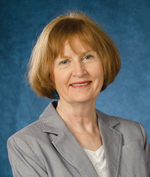Page Content
 Sixteen months into her second term as president of the Alberta Teachers’ Association, Carol Henderson has set as her top priority in 2012/13 the improvement of teachers’ conditions of practice.
Sixteen months into her second term as president of the Alberta Teachers’ Association, Carol Henderson has set as her top priority in 2012/13 the improvement of teachers’ conditions of practice.
In order to successfully transform the education system, the Alberta government requires the full support of teachers. To that end, any agreement, whether bargained locally or provincially, must address workload issues, she says. “Educational transformation is not going to work unless we listen very carefully to what teachers have to say.”
Henderson herself has listened carefully. Throughout her presidency, she has tried to maintain her connection with classroom teachers by talking with them on a regular basis in order to understand their situations and challenges and to determine how the Association can best assist them.
“You have to keep those lines of communication open,” she says. “During my two terms as president, I am determined that the Association is a place where members’ words are heard and where the values of respect, tolerance and sharing, which are so essential to me and to all members, prevail.”
Henderson attributes some of teachers’ workload issues to class composition. While she supported the inclusion of students with special needs when the concept was introduced more than 25 years ago, it seems to have eroded in the face of scarce resources and support.
“You cannot build the relationships. You can’t meet the needs of the special needs students and the English language learners and the behaviourally disordered children with no support and no assistance in the classroom,” she says. “That’s what concerns me—that the children aren’t getting the best education we can give them because of no resources, or scarce resources, and no support. We’re not giving them what they deserve.”
The Class Size Initiative, introduced in 2003 on the recommendation of Alberta’s Commission on Learning, has similarly eroded. “Teachers never know from one year to the next whether they’re going to have 20 students in their Grade 1 classroom or 30,” Henderson says.
She worries about the effect of class size and composition on teacher retention. One in every four teachers leaves the profession within the first five years, sometimes because those factors undermine their passion for teaching, she says.
“If we don’t do something for them, we’re letting them down because they have a passion for this work. You don’t last very long in this job unless you do have that passion. We have to honour their commitment and do something about their workload, or we’re going to lose them.”
Henderson maintains that the Alberta government has no excuse to not invest in education.
“We are the richest province. We are among the best in the world, and teachers as much as anybody want to maintain that status,” she says. “But we are not going to maintain our reputation unless there’s a commitment, and by commitment, I mean it does take money, and you can’t skimp out on education and expect the results that we’ve had over the past few years.”
While the government maintains it has a spending problem, in reality it has a revenue problem, Henderson says, and it could address that revenue problem by revising its “overly generous” royalty structure, by replacing the flat tax with a progressive tax or even by increasing taxes. She points out that, in a recent survey conducted by the Calgary Herald, 54 per cent of Calgarians said they would agree to higher taxes if they could be assured that the government would spend the increased revenue on their priorities.
Dealing with the government’s revenue problem would allow Premier Alison Redford to fulfill her promise to implement full-day kindergarten as recommended by the learning commission, Henderson says. In fact, she would like to see Redford fulfill not only that promise but also her promise to eliminate Grade 3 achievement tests.
“We know that Grade 3 achievement tests are 30-year-old tests that are entirely inappropriate for seven- and eight-year-olds. We also know there are different ways of assessing students and finding out what they need instead of what they don’t know. Grade 3 students need an assessment that will tell teachers the best way to help them. That’s what I think we need to focus on, not filling in bubbles with a pencil,” Henderson says.
“We expect [Redford] to follow through, and we don’t expect that it will take three or four years to do that. There’s no real reason why she can’t sign a piece of paper right now.”
